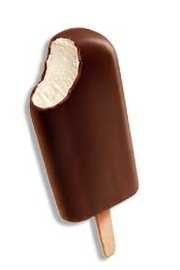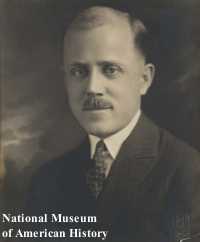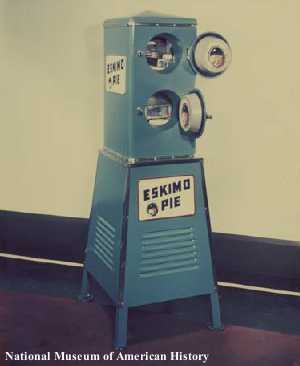 SKC Films Library SKC Films Library |
| |
| SKC Films Library >> Technology >> Home Economics
>> Cookery |
 Eskimo Pie Eskimo Piethe original chocolate-covered ice cream bar on a stick
In 1920, Nelson watched as a boy tried to decide whether to get ice cream or a chocolate bar. After the boy decided on the chocolate bar, Nelson asked him why he didn't get both, to which the boy replied "...I only got a nickel." Sensing an opportunity, Nelson immediately spent several weeks in his home kitchen trying to find the perfect method for sticking melted chocolate to ice cream before determing that cocoa butter was the best adherent. He then produced 500 "I-Scream Bars," which were a big hit at a local fireman's picnic. He then set out to find someone to help him manufacture and market his new product on a large scale. On July 13, 1921, Nelson and chocolate maker Russell C. Stover signed a handwritten contract in which they agreed to jointly produce and market Nelson's choclate-covered ice cream bar, but only if Nelson agreed to change its name to "Eskimo Pie"; the men signed the agreement the first day they met. The agreement, which was signed the very first day they met, specified that they would "coat ice cream with chocolate [sic] divide the profits equally." They also decided to sell the manufacturing rights to local ice cream companies for $500 to $1000, plus royalties on each Eskimo Pie sold. Patent #1,404,539 was granted on January 24, 1922, and Nelson trademarked the name "Eskimo Pie" that same year. Nelson and Stover began their joint business venture with an advertising campaign in Des Moines, Iowa, and sold their first 250,000 pies within 24 hours. By the spring of 1922, some 2,700 manufacturers were selling one million Eskimo Pies per day. The "Eskimo Pie novelty" had worn off by the end of 1922, however, and Stover sold his share of the company to Nelson that same year. Nelson's patent originally applied to any type of frozen material
covered with candy, and he also made sure that the word
"Pie" in a brand name frozen treat was covered
by his trademark. Unfortunately, the broad scope of both
patent and trademark led to lawsuits almost immediately.
Faced with ever increasing legal costs associated with
defending his patent and trademark, Nelson sold the
Eskimo Pie brand to the United States Foil Company (which
made the product's foil wrapper) in 1924. He did not,
however, discontinue his association with the Eskimo Pie.
On October 3, 1929, the U.S. Circuit Court of Appeals declared that the 1922 patent was invalid, due to "lack of invention," as the Eskimo Pie resembled an earlier product that also called for ice cream with cocoa butter dipped in chocolate. The judge declared that Nelson had merely changed the shape for an existing product. Even his trademark on the word "pie" was invalidated, as the judge said the word had a wide variety of uses. Nelson assigned his royalties to his wife, Myrtle Skidmore Nelson, soon after and retired to California. In 1935, a bored Nelson came out of retirement to rejoin Eskimo Pie (by then an independent company) and work on new products. In 1955, he was awarded a patent for an "Eskimo Machine," which squeezed out ice cream of the correct dimensions which was then cut into bars. He continued to create ice cream innovations, such as ice patties and colored ice cream holiday centers within Eskimo Pie products, until officially retiring from Eskimo Pie in 1961. He died on March 8, 1992. INTERNET SOURCE SEE ALSO |
SKC Films Library >> Technology >> Home Economics >> Cookery This page was last updated on January 24, 2017. |
 Christian
K. Nelson (left) was born on March 12, 1893, in
Gunstrup, Denmark, to Pedar Nelson and Margerethe Madesen
Nelson. While Nelson was an infant, the seven Nelson
children and their parents emigrated to the United
States. The dairy farming family settled in Illinois,
Wisconsin, and finally in Iowa in 1903. In Onawa, Iowa,
Nelson opened a small confectionery shop near the high
school where he worked as a teacher.
Christian
K. Nelson (left) was born on March 12, 1893, in
Gunstrup, Denmark, to Pedar Nelson and Margerethe Madesen
Nelson. While Nelson was an infant, the seven Nelson
children and their parents emigrated to the United
States. The dairy farming family settled in Illinois,
Wisconsin, and finally in Iowa in 1903. In Onawa, Iowa,
Nelson opened a small confectionery shop near the high
school where he worked as a teacher. In 1925, after the invention of dry
ice, Nelson began marketing thermal jugs with dry ice
supplied with Eskimo Pies to vendors without access to a
freezer (right). This increased visibility and
distribution and made Eskimo Pie an "impulse"
item.
In 1925, after the invention of dry
ice, Nelson began marketing thermal jugs with dry ice
supplied with Eskimo Pies to vendors without access to a
freezer (right). This increased visibility and
distribution and made Eskimo Pie an "impulse"
item.